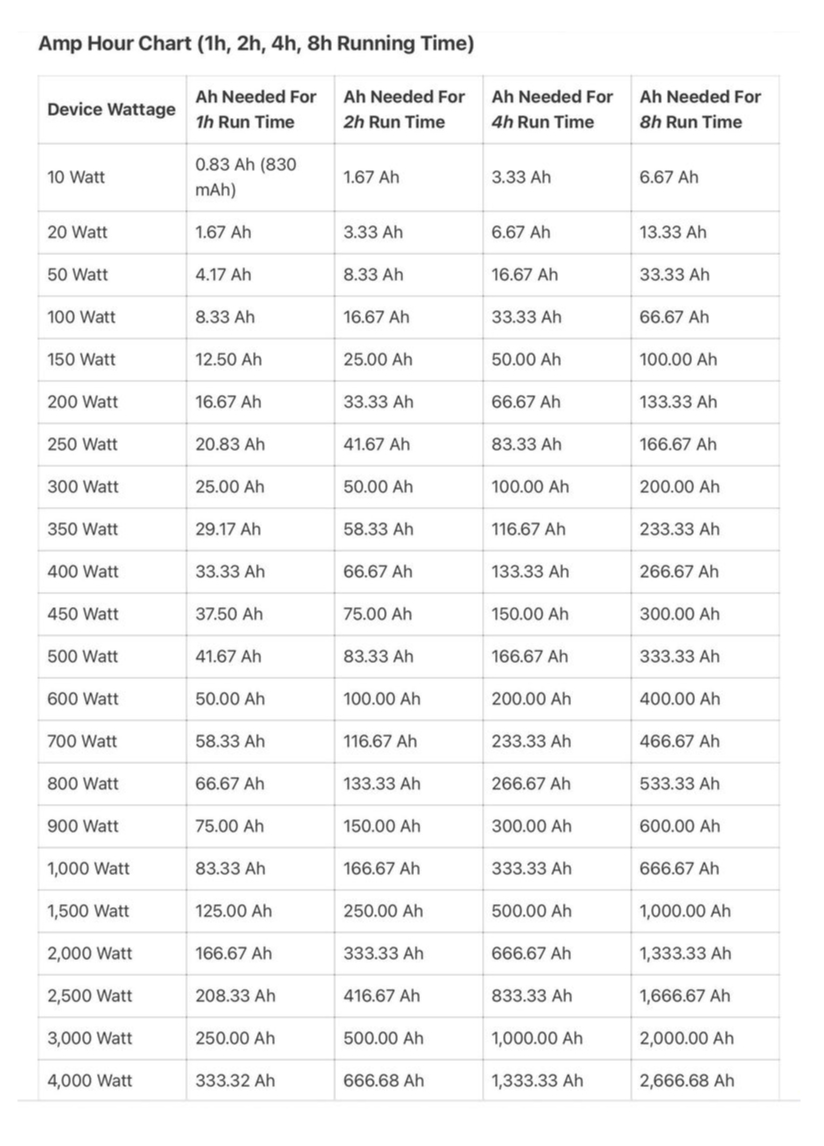
IN CONVENTIONAL LIFE we got used to almost limitless electricity being only an outlet away. We rarely thought about how much power our stuff consumed until we blew a fuse, tripped a circuit breaker, set something on fire, or got the electrical bill.
But living off-grid means living without the grid that delivers the mighty river of excited electrons. We nomads have to provide our own electricity if we want it.
So among the frequently asked questions from those preparing to live in a vehicle are, “How much solar and battery capacity will I need?” and, “Will this amount of electricity be enough to run this, this, this and this?”
How to figure it out
Somewhere on every electrical device there’s a label listing how many Watts it draws when in use. Some appliances use more at startup to get all the parts moving or to bring things up to temperature. Some cycle on and off to maintain temperature settings. But anyway, the Watt rating on the device is a suitable place to begin figuring power usage.
For actual real-world wattage draw numbers, you can plug your AC-powered things into a Kill-A-Watt meter. If you already have a power station, its meters will also give you that information — and for your DC-powered devices as well. (But you want to know how much power you’ll need so you can get a sufficiently powerful power station, so… yeah, the Kill-A-Watt.)
Go though all the electrical things you want to use in your rig and write down their Wattage. Then estimate how much time each day you will be using the thing. A few seconds for a blender? A few hours for a slow cooker? All day for a heater or air conditioner? When in doubt, round your numbers up. Compare your numbers to this chart.

For example, you might use a 300W mini cooker for 15 minutes twice a day. Three-hundred Watts uses 25Ah per hour, so 12.5Ah for a half hour.
Another example: a 700W microwave for 3 minutes (5% or 1/20 of an hour). Divide the 58.33 Ah that 700W would use in an hour by 20 and get 2.9Ah.
A CPAP machine with a humidifier uses about 90W. So 100W for 8 hours is 66.67 Ah.
According to Kill-A-Watt, charging my laptop draws 44W. My 20,000mAh battery pack draws 18W when charging. My hot spot draws 15W. My phone draws 13W.
Finally, add up the Amp hours to get your estimated daily use.
Amp hours versus Watt hours
After doing all that arithmetic, you might need to do more. If you’re assembling your own electrical system using lithium batteries, you’re in luck. Those batteries are not only rated in Amp hours, you can also use almost all of those Amp hours between recharges.

If you’re using deep-cycle lead-acid batteries (AGM’s for example), they are also rated in Amp hours. However, you can use only half of those Amp hours between recharges, otherwise you will ruin the batteries. So you’ll need twice as many Amp hours to do the same job as lithium batteries.
As for power stations (which also use lithium batteries), they’re rated in Watt hours. Because, reasons. You can use this handy online converter to get figure out the equivalent Amp hours.
Something else to take into account
Let’s say you use up most of your electricity in a typical day and you’re going to recharge your system with solar the next day — while still drawing electricity for your daily uses. This is like trying to fill a bucket with a hole in the bottom. Is power going out faster than it’s coming in? And the situation is worse during periods of less sunlight. So you would need greater Amp hour capacity. Or a faster way to recharge. Or you could reduce your usage.
Reality check
If your calculated electricity use is higher than you had expected, you have to decide whether you want to spend what’s necessary for a system that will produce enough electricity (with some to spare) or whether you’ll give up some of the stuff on your electrical device wishlist. Sunlight is free, but not the system needed to turn sunlight into refrigeration, dinner, heat, cool air, entertainment…

Hope some of YOU tell how you use, keep, store your electric.
I make/use ~1.75kWh/day on average. 95% of this comes from 750w solar and 5% from alternator (VSR). I’ve seen >4kWh/day when the spurs are put to it under good conditions but mainly the extra panel is there for winter + rainy day support.
Storage is 100Ah of LiFePO4. I don’t need more storage because most of my use is daytime and “off the panels”.
Offgrid in the rig for the last 1,616 days.
All of this . . . why are nomads that I’ve seen here so into making their nomad life look like city life. Perplexing to me.
No one is recommending “all of this”. The items are there as fodder for the math. We can think of them as Generic Load A, Gen eric Load B, etc.
> Perplexing to me.
It’s almost as if people have different preferences.
Alexa, ‘ all of this ‘ may be due to the fact that while on the road there is a need to preserve food in a tiny fridge, to have @ bit of power to activate the fan when the van is hot & suffocating & so on… Comfort isn’t a bad word & shouldn’t be privilege of bricks / sticks dwellers …I may be wrong though, but that’s the way I see it ?. PS: I’, not @ nomad.
Alexa, back when I was an “Ant” Ref: Bob Wells speech at 2023RTR, I was a mountaineering expert. So everything that you need you carry on your back. But stuck in my tent in a storm on the side of a mountain I would dream of the ultimate conveniences of having a bathroom, a kitchen, a soft warm bed, and sometimes even my TV with movies or music to listen to. That was my bucket list for living extremely large. So now I “Car Camp.” That’s what we called this stuff 50 years ago. So based on function, “form follows function,” I designed my dream tent. I just stuffed it all into a van conversion. Now I can pull over and take a nap in 30 seconds. I can make it to the fully functional bathroom in less than 10 seconds, sometimes I need to.
I need my comfort. I don’t need an apartment or a house, and not yet an “old folks home.” I did minimalism to the far edge of extreme. Now I’m living large in the tall grass as a typical modern day nomad. Look up Chinese Nomads and how they did it. They did all their cooking with a single wok. They had one pot and they learned how to do everything with just one pot to rub clean. This nomadic thing has been going on for a very long time.
Thanks so much for this article! Very useful and informative.